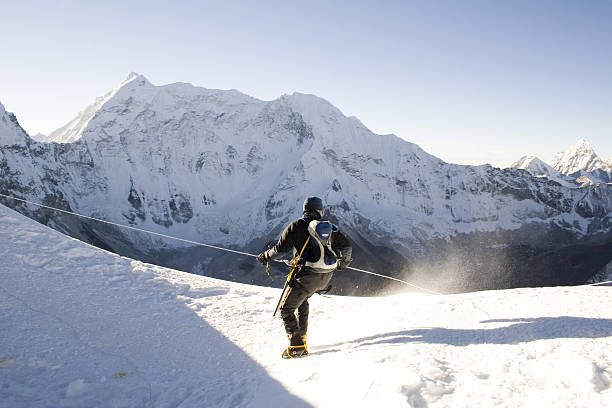Contact Us
Mera Peak Climbing
Description
Included/Exclude
-
Airport Transfers:
- Arrival and departure transfers between the airport and the hotel in Kathmandu.
-
Accommodation:
- Accommodation in Kathmandu before and after the trek in a standard hotel.
- Teahouse or lodge accommodation during the trek.
-
Meals:
- Full board meals during the trek (breakfast, lunch, and dinner).
- Meals include a variety of local and international dishes.
-
Internal Flights:
- Round-trip flights between Kathmandu and Lukla.
-
Trekking Permits:
- Makalu Barun National Park entry permit.
- TIMS (Trekkers’ Information Management System) card.
- Mera Peak climbing permit.
-
Professional Guides:
- Experienced and licensed trekking guides.
- Climbing guides trained for Mera Peak.
-
Porter Services:
- Porter services to carry trekking equipment and personal belongings (usually a specific weight limit).
-
Climbing Equipment:
- Group climbing equipment (ropes, ice screws, snow bar, etc.).
- Tents for high camps during the climbing period.
-
Climbing Sherpa:
- A qualified climbing Sherpa to assist and guide during the ascent.
-
Climbing Clinic:
- Basic climbing training and instruction at the Mera Peak Base Camp.
-
Safety Equipment:
- Group first aid kit.
- Emergency oxygen and high-altitude medical kits.
-
Transportation:
- All ground transportation in Nepal as per the itinerary.
-
Contingency Plans:
- Contingency days in case of bad weather or unforeseen circumstances.
- Helicopter evacuation services (if necessary).
-
Certificate:
- Summit certificate upon successful completion of the climb.
-
International Flights:
- Airfare to and from Nepal is generally not included.
-
Travel Insurance:
- Comprehensive travel and medical insurance coverage are usually not part of the package. It is highly recommended that climbers purchase insurance that covers high-altitude trekking and climbing activities.
-
Personal Gear:
- Climbing and trekking gear such as boots, crampons, harness, helmet, and personal clothing are typically not provided and need to be arranged individually.
-
Visa Fees:
- The cost of obtaining a Nepalese visa upon arrival in Kathmandu is not included.
-
Vaccinations and Health Expenses:
- Vaccinations and any health-related expenses are usually not covered.
-
Meals in Kathmandu:
- Meals in Kathmandu (other than those specified in the itinerary) are not included.
-
Personal Expenses:
- Expenses for items such as snacks, beverages, souvenirs, and personal toiletries are not covered.
-
Tips and Gratuities:
- Tips for guides, porters, and climbing Sherpas are generally not included in the package.
-
Additional Accommodation:
- Any extra accommodation needed due to unforeseen circumstances or changes in the itinerary.
-
Additional Services:
- Optional activities or services not specified in the itinerary.
-
Excess Baggage Charges:
- Charges for excess baggage on domestic flights or other transportation modes.
-
Evacuation Costs:
- Costs associated with emergency evacuation by helicopter in case of altitude sickness or other emergencies.
Itinerary
- Day 01: Arrival day
- Day 02: Fly to Lukla and trek to Paiya (Chutok) [2730m/8954ft]:3-4 hrs
- Day 03: Paiya to Pangkoma [2850m/93,48ft]: 5-6 hrs
- Day 04: Pangkoma to Nigmsa (Shibuche)[2745m/90,003ft]: 4-5 hrs
- Day 05: Nigmsa (Shibuche) to Chetrakhola [3150m/10332ft]: 7-8 hrs
- Day 06: Chetrakhola to Kothe [3600m/11808ft]: 6-7 hrs
- Day 07: Kothe to Tangnang [4,350m/14,270ft]: 3-4 hrs
- Day 08: Acclimatization Day: Hiking to Charpate Himal Glacier
- Day 09: Tangnang to Khare [5,045m/16,486ft]: 2-3 hrs
- Day 10: Khare to Mera Base Camp [5300m/17,384ft]: 3-4 hrs
- Day 11: Mera Base Camp to High camp [5,780m/18,958ft]: 4-5 hrs
- Day 12: Mera High Camp to Summit[6,461m/21,1907ft] and back to Khare [5045m/16,547ft]: 8-9 hrs
- Day 13: Reserve day for Contingency
- Day 14: Khare to Kothe [3600m/11808ft]: 4-5 hrs
- Day 15: Kothe to Thuli Kharka: 5-6 hrs
- Day 16: Thuli Kharka to Lukla: 6-7 hrs
- Day 17: Fly to Kathmandu
- Day 18: Departure day


